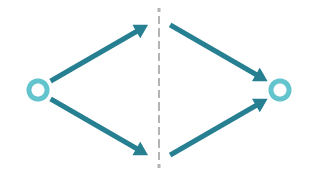Divergent and convergent thinking

Creative concepting is often unpredictable, chaotic and can be hard to explain. But at its highest level, the entire process can be broken into two phases: divergent thinking (which is all about creating choices) and convergent thinking (which is all about making choices). The ability to do both at a high level will help ensure your creative solutions are thoughtful, strategic, fresh and interesting.
Divergent Thinking
The best way to kick off divergent thinking is with a single problem to solve. In creative concepting, a clearly-defined strategy is usually the starting point. From there, we attempt to come up with as many solutions as possible. We call it “casting a wide net.” The goal is to push past the safe and obvious answers and uncover solutions that are fresh, unexpected, and even ridiculous.
At this point, it’s important to reserve judgement, as that can inhibit the flow of ideas. You never know when a seemingly random thought or off-the-wall statement might serve as the jumping off point for a strong, fully-developed concept. It’s helpful to have a team working together during this phase to expand the collection of ideas. Each person will bring a unique perspective, and the back-and-forth discussion between team members will usually spark additional thoughts. The key is to capture everything here, so you can go back and revisit all the ideas during the next phase.
Convergent Thinking
Now that you (presumably) have a giant pool of possible solutions, it’s time to start sorting through everything and evaluating the ideas against the original problem. Most of the ideas will be discarded for any number of reasons (too predictable, not feasible, too abstract, etc.). This phase is methodical, analytical and somewhat intuitive. Some of the ideas will need more development before you decide to keep them in the mix or cast them aside. Part of what makes a creative team successful is the ability to identify the potential of a rough idea and know when it’s time to move on from ideas that fall short.
In the purest form of convergent thinking, you narrow down your ideas to a single solution. But in the creative world, we usually narrow it down to a few solutions. The magic number is usually three, which is enough to show variety, but not too many to be overwhelming when presenting to a client.
Conclusion
The chances of arriving at a strong creative solution rely on your ability to master both divergent and convergent thinking. If you fall short in the divergent phase, your pool of possible solutions will be smaller and the solutions might seem obvious or uninspired. If you fail during the convergent phase, your solutions might feel convoluted or half-baked. Both disciplines take practice. And both are critical to successful creative problem-solving.
